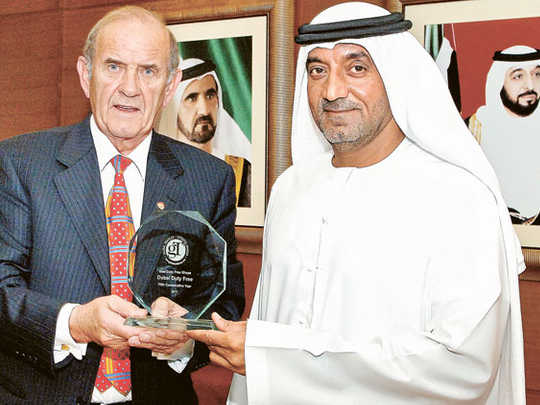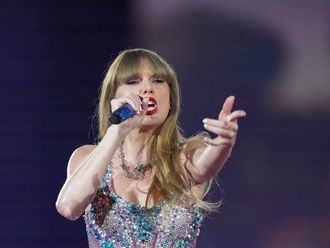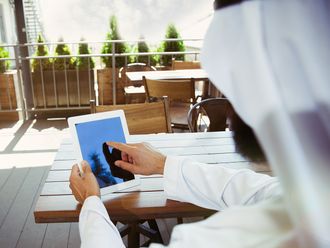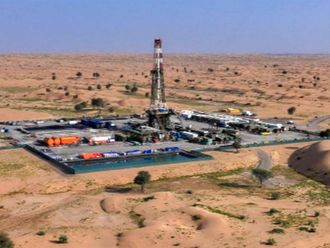
Some people shop at an airport duty free out of necessity, others shop to kill time. But some people shop because it's there. However, in Dubai, a large number of South Asian average wage earners do shop more at the airport due to weight restrictions on unaccompanied baggage.
As weight limits shrink, these expatriates find duty free an easy way out to beat the system — which explains why sales volumes at the world's largest travel retailer increase year after year — in addition to a higher number of passengers carried by Emirates airline that uses the airport as its hub.
Emirates receives three wide-bodied aircraft on average every two months — with additional seat capacity exceeding 1,000. An Emirates aircraft flies in or out of the airport every three to five minutes, carrying more than 200 passengers.
These are in addition to the more than 100 airlines serving the world's fourth biggest international airport.
Dubai Duty Free (DDF), the world's largest travel retailer, generated sales revenues of $1.27 billion (Dh4.66 billion) in 2010 and it expects the sales to grow 15.45 per cent to $1.45 billion last year.
Colm Mclaughlin, Executive Vice-President of DDF, says he expects sales to touch $1.64 billion in 2012.
"Our sales projections are for Dh6 billion in 2012 and we are confident of reaching that," he said.
Travellers bought 1.21 million kilogrames of Tang, 785,606kg of Nido, 2,114kg of gold, 166,703 watches, 1,997,371 bottles of perfume, 121,489 mobile handsets, 3,029,097 cartons of cigarettes, 764,017kg of nuts and 761,116kg of Kitkat during the first nine months of 2011.
"The passenger growth for 2011 is expected to be around 8 per cent while DDF sales growth is close to 15.45 per cent and that is obviously good from our point of view as it means that our penetration level, which is around 50 per cent of all departing passengers, is very good. Of course, we can always improve on that and we intend to do that in 2012."
Dubai International handled 46.28 million passengers in the first 11 months of last year and was poised to cross the 50 million mark by the end of 2011. Of them, less than half would be outgoing passengers. A 50 per cent penetration of the outgoing passengers means, more than 10 million people have bought something at DDF.
Tony Tyler, Director-General and CEO of the International Air Transport Association (IATA), recently said that the UAE was expecting an 8.5 per cent average annual growth in passenger traffic through 2015.
"If that materialises, in 2015, the Middle East and North Africa [Mena] will handle 86.6 million international passengers — nearly 30 million more than in 2010. And it will be the eighth largest market for international travel — only slightly smaller than China at 90 million passengers and well ahead of Japan at 70 million. This will be an extraordinary achievement," Tyler said.
Going home
This means Dubai International alone handles more than 50 per cent of all the passengers that travel in and out of the Mena region. This is also reflected in the DDF sales revenue — which is about half of the total duty free sales in Mena.
Most South Asian workers travel back home on holiday at least once in two years. On average, they spend $500 to $1,000 on merchandise, clothes and gift items — which along with their essential belongings cover the 30kg-40kg weight allowance.
While packing, most of them scratch their heads on how to carry more — the biscuits, chocolates, creams, soaps, nuts, toiletries, perfumes and powdered milk.
Thus, duty free provides them with the best solution, as there aren't any visible restrictions on how many kilograms one could add at the duty free. To make things easier, they carry extra empty bags to stuff in goods at the duty free.
For a worker who travels once a year, 40kg might not meet the wish-list. That's why many of them can be found carrying an additional 20-25kg of baggage while they board the aircraft.
"The lure of tax-free goods is probably the single biggest driver for growth, but the increased marketing and pricing discounts mean that customers are simply buying more," said Saj Ahmad, Chief Analyst at StrategicAero Research.
"The rise in passenger growth doesn't necessarily mean all of them will make duty-free purchases. The last thing I bought from Dubai Duty Free was an Emirates airplane model, while others will spend hundreds and thousands more dirhams on jewellery and other products such as electrical goods, which would otherwise incur higher taxes in places like Asia, the EU and the US. It's a combination of factors that are at play and with more consumer choice within the duty free umbrella, customers will continue to buy more luxury items."
Apart from the South Asian travellers, the influx of Chinese businessmen is contributing to the growth.
Fastest growing
"At the moment, Chinese passengers in particular are an important and growing group. The Chinese are looking for high-end luxury products, in particular watches and fashion and they enjoy great savings on these compared to their domestic market," Mclaughlin says.
Duty free shopping is one of the fastest growing businesses in the world. Worldwide duty free sales jumped from $15 billion in 1991 to $39 billion in 2010. It is one of those sectors that continues to grow even during recessions.
While the airline industry is still suffering globally from the economic slowdown, travel retail sales continue to grow.
They grew from $34.5 billion in 2009 to $39.1 billion last year, according to data compiled by Generation Research.
On average, 20 per cent to 30 per cent of travellers shop at duty free outlets.
However, at the DDF, the penetration is about 50 per cent. But what about pricing and profit margins? How have they changed during the financial crisis?
"With cost-conscious customers wanting even greater value for money at a time when retailers are engaged in cut-throat sales tactics, it's easy to see margins suffer ing, so perhaps profitability isn't yet being matched with the same growth in revenue," Ahmad says.
"But consumers won't care as long as they grab a good deal — especially while there is seemingly no weight limit for air side purchases at Dubai International Airport. Many people are taking advantage of this and it's likely that while profits will rise, it won't be anything like what retailers would imagine."
World's biggest
Despite the ongoing slowdown in global economy, surprisingly, luxury goods top the list of all the sold items at duty free outlets worldwide, amounting to $14.07 billion, or 36 per cent of the market, followed by perfumes and cosmetics, worth $11.96 billion.
Despite the recession, Europe remains the world's biggest duty-free market with sales exceeding $13.86 billion, followed by the Asia Pacific region at $12.6 billion.
Duty free sales in the Middle East are relatively small, about $2.85 billion — half of which are done through DDF, which has become the world's largest travel retailer, with sales poised to hit $1.45 billion last year.
----
Eyeing expansion
Concourse 3 to add 8,000 square feet of space
Dubai: As the year closes, Gulf News caught up with Colm McLoughlin, Executive Vice-President of Dubai Duty Free (DDF), who nearly single-handedly developed DDF from a small travel retail operation to the world's biggest in less that three decades.
McLoughlin came to Dubai in 1983 from Ireland on a six-month assignment to help the then Dubai Department of Civil Aviation set up its duty free operations. Following its successful start, he was asked to take over the operations. It became his home.
In July 2011, McLoughlin was named Executive Vice-Chairman of Dubai Duty Free and its subsidiary businesses, which include The Aviation Club, Irish Village, Century Village and Dubai Tennis Stadium; home to the Dubai Duty Free Tennis Championships. McLoughlin's remit also includes the soon-to-open Jumeirah Creekside Hotel.
About 28 years on, DDF registers 60,000 transactions a day and sells 71 million items of merchandise every year.
DDF is currently contributing to the emirate's economy in a bigger way. It is developing a number of facilities, including a five-star hotel at the Irish Village. It will part-finance the development of a new concourse and terminal, part of the Dh28-billion expansion of Dubai International Airport.
McLoughlin shares his thoughts on the overall industry and DDF. Excerpts:
Gulf News: With the year ending, where do you see DDF sales hitting in terms of sales value and percentage of growth?
Colm Mcloughlin: As per current rate of sales Dubai Duty Free is predicted to finish at Dh5.3 billion ($1.45 billion) in retail sales, a 15.45 per cent increase over last year.
Could you shed some light on travellers' shopping trends at the DDF, based on your findings?
Chinese passengers in particular are an important and growing group.
In October around 40 per cent of luxury watches sold were purchased by Chinese travellers while 31 per cent of handbags were sold to them. In the third quarter of last year we saw massive growth in other luxury watch brands including IWC, which grew by 203 per cent.
Armani fashion is another favourite and the Chinese are the biggest buyers of Armani at DDF.
We are looking to increase these figures by ensuring that a number of procedures are in place, not the least of which is ensuring that we have the most popular brands available for the Chinese passengers, that we have sufficient Chinese staff in place and that the passengers have a convenient payment system such as Union Pay.
We are increasing our Chinese signage as well and we have improved the positioning and display of high demand products, such as Chungwa cigarettes. Chungwa is the top-selling single product at Dubai Duty Free right now.
Indian passengers have always been an important part of our passenger mix, and continue to do so. The figures indicate that there are more high-spending Indian travellers and of course we need to capture their spend as much as possible.
How does 2012 look like — outlook and projections?
Dubai Duty Free will continue to enhance and expand its retail operation in 2012 and beyond.
Currently operating some 18,000 square metres of retail space at Dubai International Airport, the operation will grow by a further 8,000 square metres with the opening of Concourse 3, which like Terminal 3 will be dedicated to Emirates airline.
In addition, Dubai Duty Free is preparing to open its first hotel, the Jumeirah Creekside Hotel, next year. The five-star property will be managed by Dubai-based Jumeirah Group and is located on the grounds of the Aviation Club in Garhoud.
What is driving your growth in sale, other than the passenger growth?
We have seen consumer spending increase across most categories including significant growth in the luxury sector. The top three selling categories continue to be perfumes, liquor and gold. All of this indicates that travellers are spending again, or at least certain nationalities are continuing to spend.
We also benefit from having a dynamic airport environment and year-on-year passenger growth but from a retailer's point of view we have to ensure that we attract those passengers and turn flyers into buyers.
I think that having the right product mix, having the latest product range and, where possible, continuing to work with suppliers on retail exclusives, have contributed towards the increase in sales.
Is your sales growth proportionate to the growth in passenger traffic?
The passenger growth for 2011 is expected to be around 8 per cent while DDF sales growth is close to 15.45 per cent and that is obviously good from our point of view as it means that our penetration level, which is around 50 per cent of all departing passengers, is very good.
Has the per capita spend gone up?
The average spend per departing passenger is around $49 (Dh179.83), while the average spend per arriving passenger is $9, which is good, but again, we will aim to drive average spends higher next year.
Firstly, our penetration level at around 50 per cent compares favourably with the industry average of 20-30 per cent.
The average spend per departing passenger is also relatively high at $49 compared to other airports, but we can never become complacent about this.











